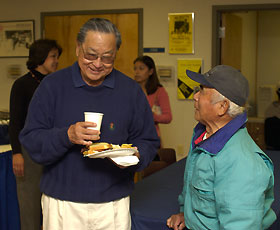|
This is an archived article.
For the latest news, go to the
Advance Homepage
For more archives, go to the Advance Archive/Search Page. | ||
|
Japanese-Americans Recall Returning to the UConn campus after 60 years, Kay Kiyokawa was amazed how much the campus had grown. Jim Nakano felt nostalgic when he saw the old buildings. Teri Yeya Yatsu was grateful for having made lifelong friends.
The three, on campus October 16-19 for a reunion, were among 19 Nisei, or second-generation Japanese-Americans who attended or graduated from UConn during World War II. UConn was the only university in Connecticut that accepted students from internment camps. Following the Japanese attack on Pearl Harbor in 1941, the U.S. was gripped by fear of a Japanese attack on the West Coast. In 1942, President Franklin D. Roosevelt signed Executive Order 9066 authorizing the internment of more than 120,000 Japanese-Americans , two-thirds of whom were citizens of the U.S. None had ever shown disloyalty. The detainees were sent to internment camps, mostly in isolated inland areas of the country, where they were forced to live under harsh conditions. Young detainees were given the option of staying in the camps or attending college. But nationwide there was strong anti-Japanese sentiment, and many universities refused to enroll them. Kiyokawa was a college student attending Oregon State University in 1942 when the evacuation notice came. He and his family were forced to leave their 150-acre farm in Oregon's Hood River Valley, and were taken to an internment camp in Northern California. With the help of the Quaker church, Kiyokawa would come to Storrs for his education. "My two-year stay at UConn was the most memorable experience in my life," says Kiyokawa, who studied horticulture. "Students were very friendly and the facilities were outstanding." He says he felt no discrimination. Kiyokawa was co-captain of the baseball team. "For two years I was the leadoff batter, and when I wasn't pitching, I played center field," he says. He also played football. He recalls a special moment after his final baseball game. "Half a dozen Pi Beta Phi pledges came running onto the field and removed my baseball cap and replaced it with a Pi Beta Phi pledge's hat," he says. Yatsu says coming back to campus "brings back wonderful memories. I was living in Holcomb and a hurricane was coming. The housemother sent us all downstairs into the lounge. There were candles and we huddled around and sang songs. It was bonding." Nakano says when he came to UConn as a freshman in 1943, "I was naíve. I never met so many people so quickly. I had two good years of college life." Kazuo "Kaz" Yamaguchi is one of the few Japanese-American students who attended UConn in the early 1940s but did not come from an internment camp. He grew up in New York. "I lived in Ozone Park, predominantly Italian-Americans," he says. "We were all children of immigrants. I wasn't exposed to any indignity." But UConn was the only school that accepted his application. "No other schools did," he says, adding that he "really didn't understand what was happening." The reunion was sponsored by the Asian-American Cultural Center and the Asian-American Studies Institute with support from the Alumni Association, the College of Liberal Arts and Sciences, the School of Engineering, and the Division of Athletics. It was part of the 10-year anniversary of the cultural center and institute. The eight alumni who attended the four-day reunion were interviewed for the "Nisei at UConn - An Oral History Project" sponsored by the Center for Oral History. |

